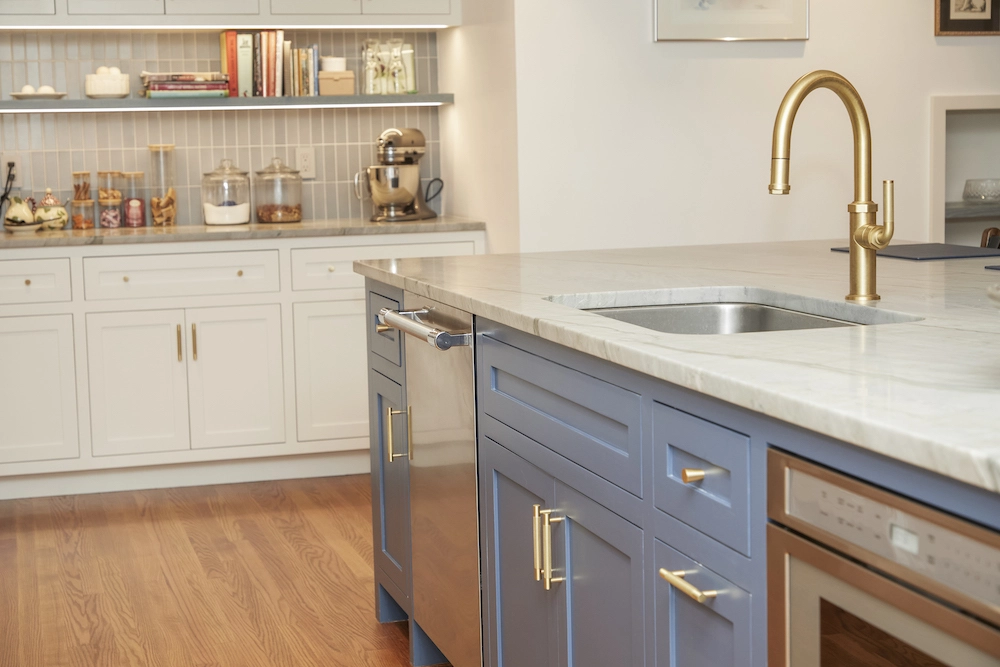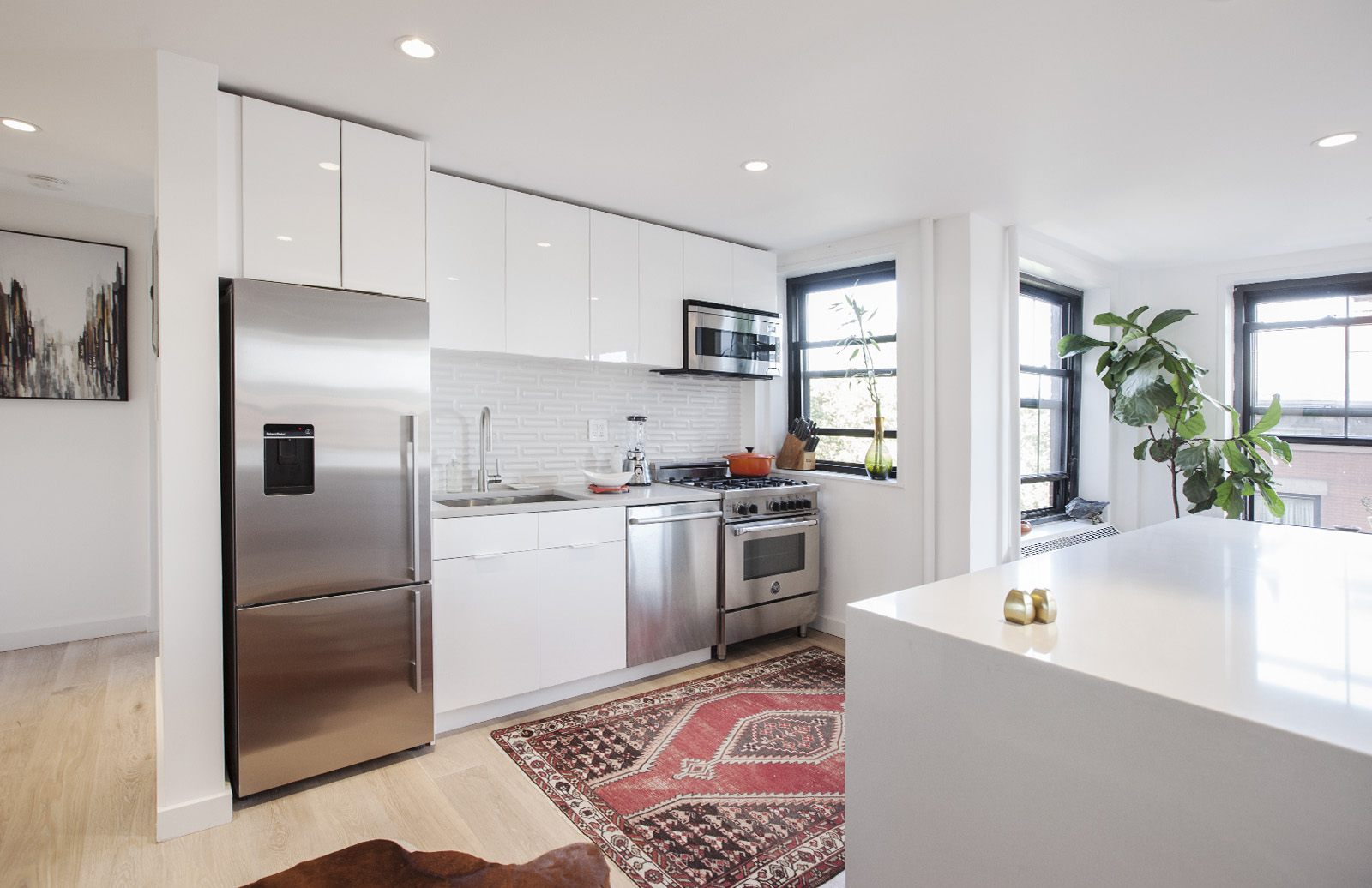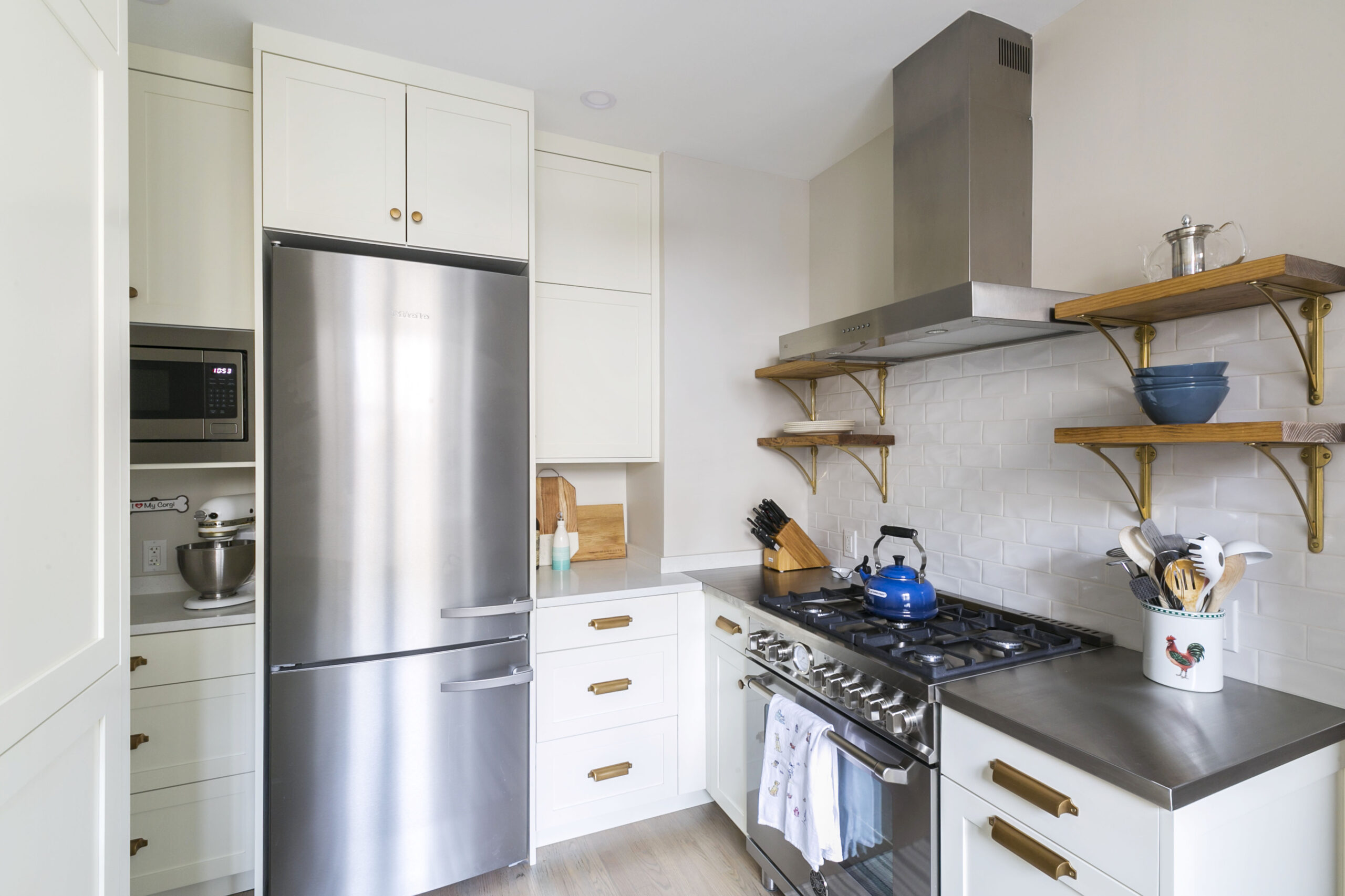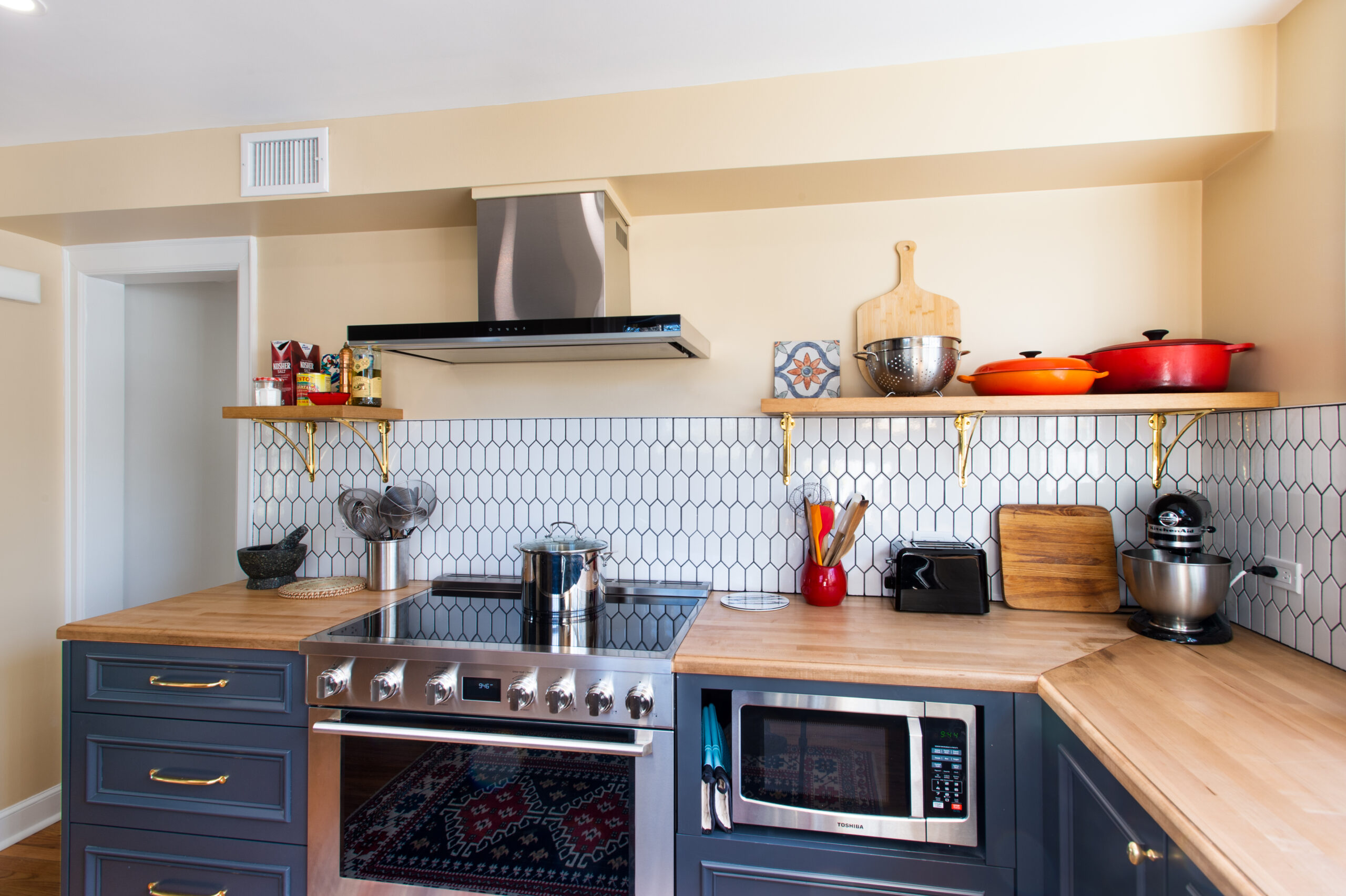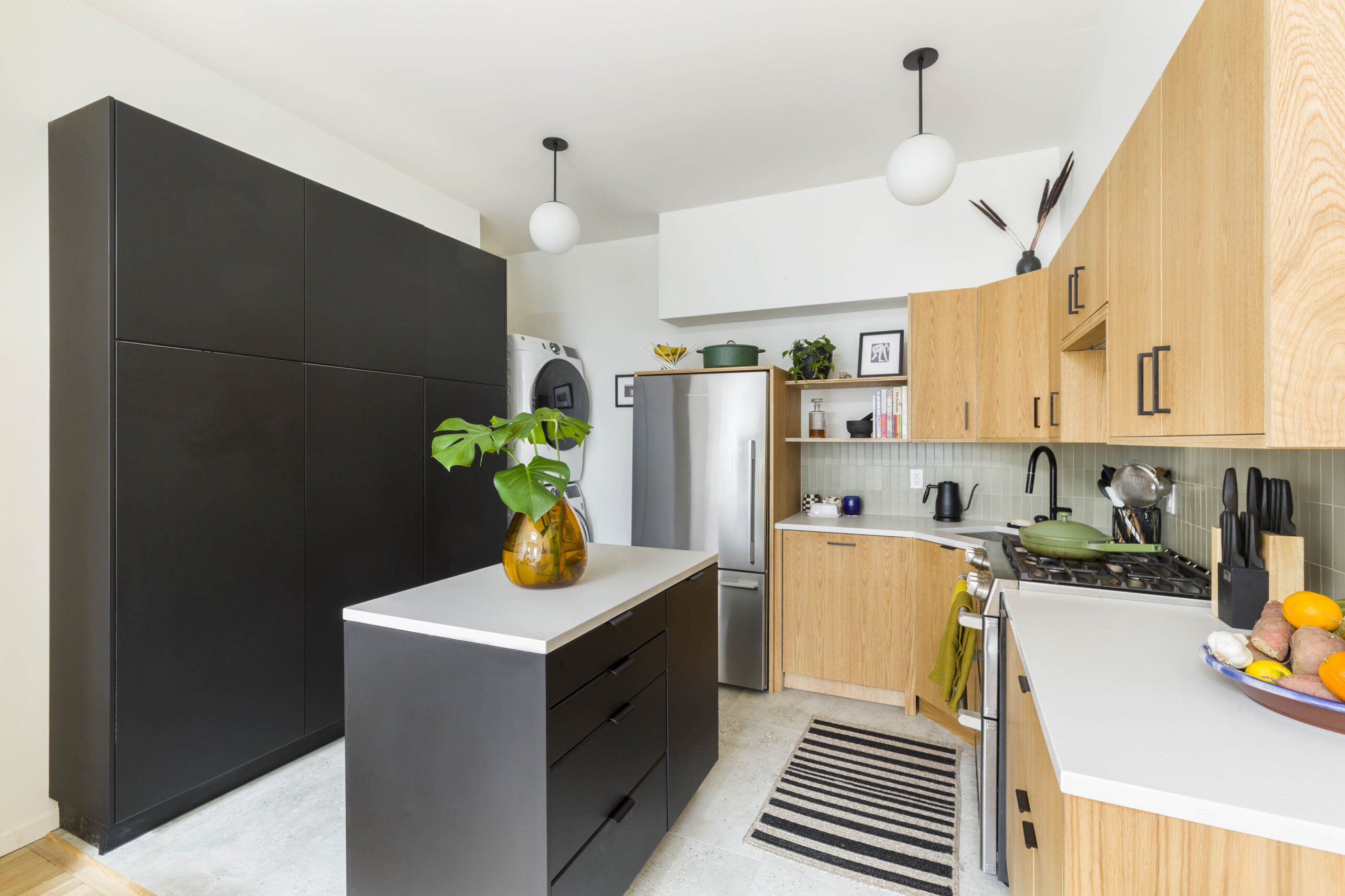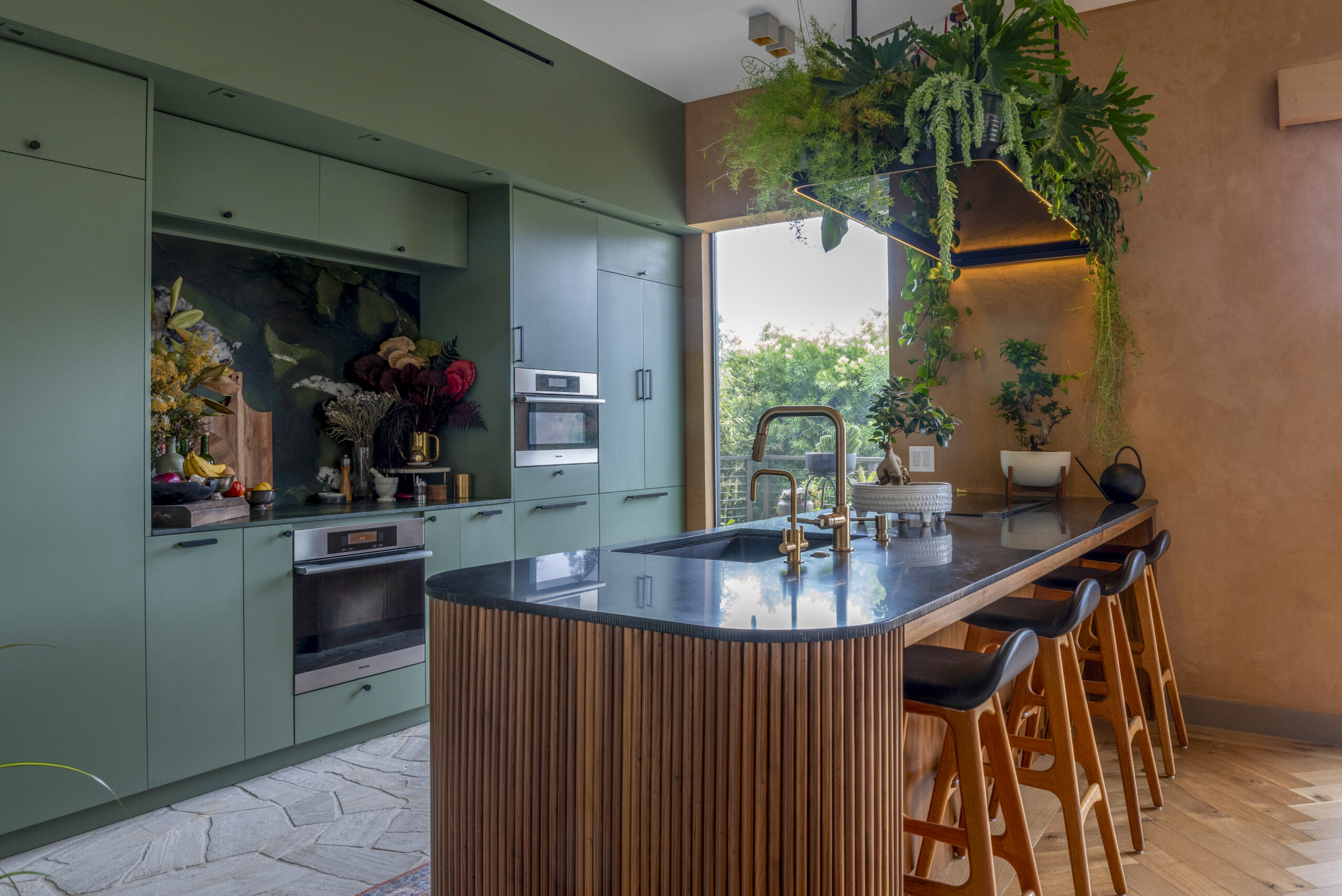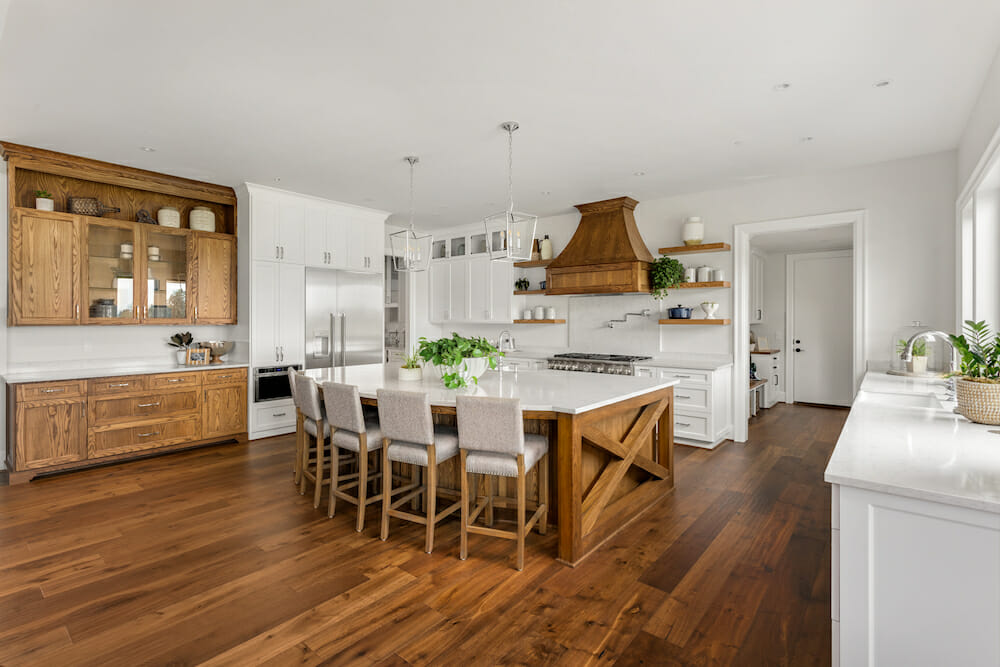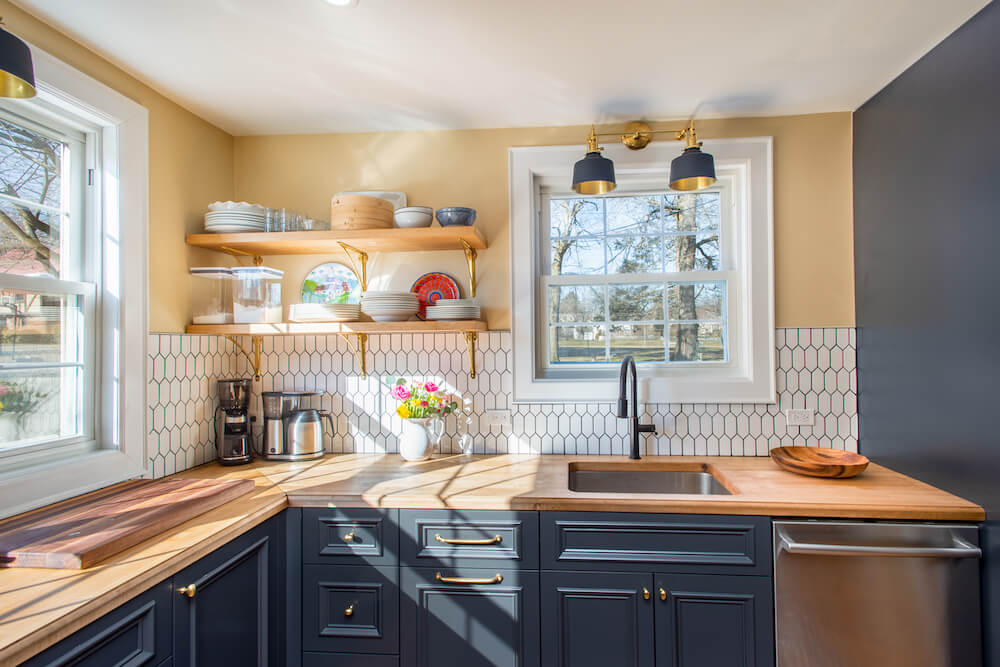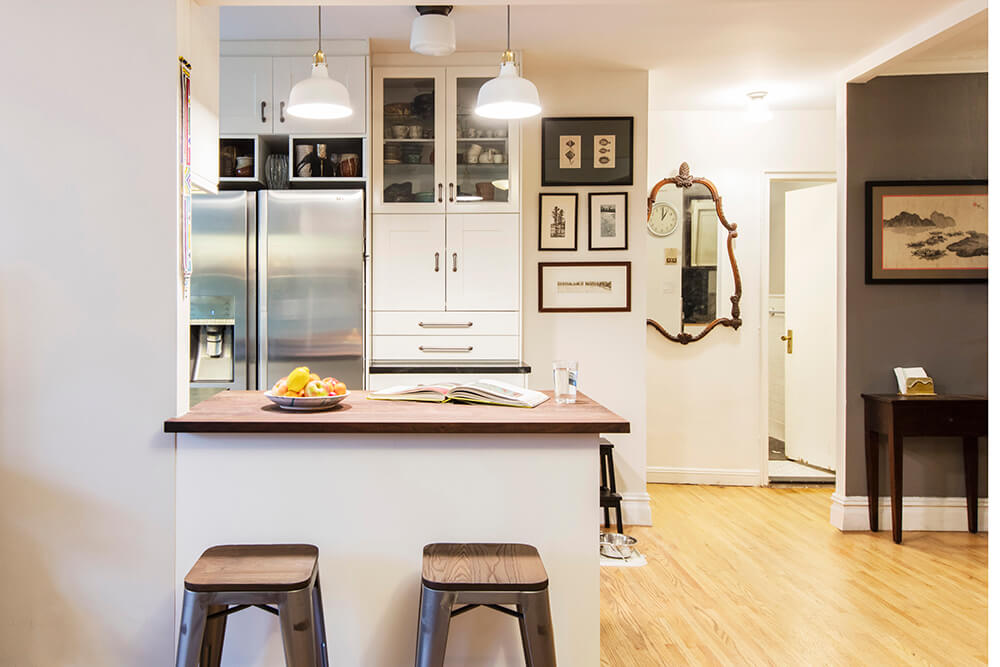Home / Blog / Home Renovation Cost Guides
How Much Should You Budget for a Chicago Kitchen Remodel in 2025?
Navigating the world of kitchen remodel costs in Chicago can feel like deciphering a secret menu, but don’t worry! This guide is your culinary compass, leading you through the maze of factors that influence the price tag.
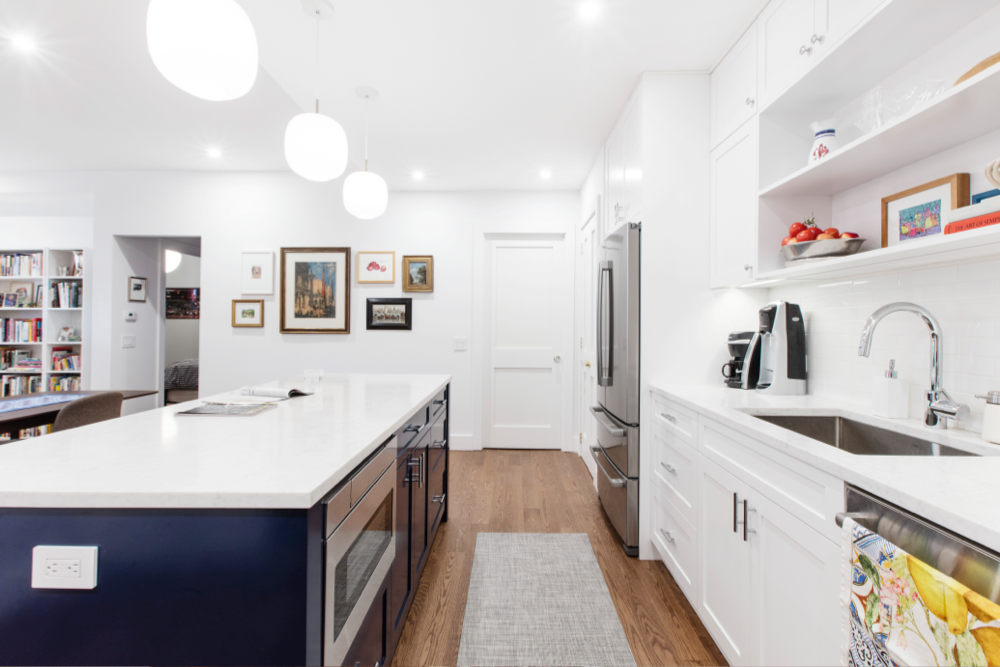
How much should you budget for your kitchen remodel? Here’s how to make a rough prediction of kitchen remodeling costs in Chicago. The main variables are:
- Size of your kitchen, typically determined by square footage, and other factors like the number of linear feet of cabinets and countertops you need.
- Finish level — from budget to luxury, of all the materials, fixtures and finishes for your renovation.
- Scope — Are you just replacing fixtures and finishes? Are you changing the floor plan, including moving walls and utilities? Are you adding a new kitchen, or moving your kitchen to a different part of the house?
- Services — Do you just need construction work? Do you need professional design or architecture services?
At Sweeten, we’re experts at all things general contractors — we pre-screen them for our network, carefully select the best ones for your remodeling project, and work closely with hundreds of general contractors every day. So, we’ve tapped our internal expertise to bring you this guide.
We’ll discuss these variables below, but for now let’s start with an example.
For a full renovation (without layout changes) of a medium-sized kitchen, with basic general contracting services, here’s what you can expect starting costs for your project to look like in Chicago for 2025:
- Budget kitchen renovation: $27,300 to $36,500. This typically includes replacing countertops, appliances, and fixtures with mid-range options, often without changing the layout or plumbing.
- Mid-grade kitchen renovation: $42,700 to $78,900. This may involve upgrading materials, adding backsplashes, and potentially making minor layout changes. This range offers a balance of quality upgrades and reasonable costs.
- High-end kitchen renovation: $82,000 to $145,000 or more. This includes premium materials, custom cabinetry, top-of-the-line appliances, and significant design elements, often with structural changes.
We want you to be completely prepared for the cost of your home remodeling project, so our pricing estimates are inclusive of all materials, labor, overhead, and a standard general contractor’s margin. It’s also important to factor in potential permit costs, which in Chicago can range from $1,500 to $3,700 depending on the scope.
When you’re ready to get started on your kitchen or home remodel, work with Sweeten to renovate with the best contractors in Chicago.
Size: How dimensions affect your kitchen remodeling costs in Chicago
Bigger kitchen, bigger budget? While it’s a common assumption, the size of your kitchen isn’t the only factor that drives up costs. What really matters are the fixtures, finishes, and appliances that fill the space. A small kitchen with high-end materials and custom features can be more expensive than a larger kitchen with basic finishes. So, when considering your kitchen remodel, focus on the details that will make the most impact on your budget and overall satisfaction.
Extra Small Kitchens
Extra small kitchens, often referred to as “kitchenettes,” are characterized by mini appliances and limited cabinetry. Typically measuring less than 60 square feet, they are best suited for simple food preparation. Common appliances in extra small kitchens include an under-counter or narrow refrigerator and a small stove or cooktop.
The cost of remodeling an extra small kitchen in Chicago can vary widely depending on the specific upgrades you choose. However, due to their limited size and scope, extra small kitchen remodels generally have a lower kitchen remodel cost compared to larger kitchens.
Small Kitchens
Small kitchens frequently feature a narrow galley or efficient corner layout. These kitchens, typically ranging from 60 to 90 square feet, are ideal for one cook. Common appliances include a narrow upright refrigerator, a four-burner range, and a microwave.
The cost of remodeling a small kitchen in Chicago can be more affordable than larger kitchens, but it still depends on the materials, appliances, and design elements you select.
Medium Kitchens
Medium kitchens often have an “L” or “U”-shaped layout, sometimes with an island or peninsula. Measuring between 90 and 120 square feet, medium kitchens comfortably accommodate 1-2 cooks. Typical appliances include an upright refrigerator, a four-burner range, a dishwasher, and a microwave.
The cost of remodeling a medium kitchen in Chicago can vary significantly based on your desired level of luxury and customization.
Large Kitchens
Large kitchens offer ample cabinet space or a pantry, often featuring an island or peninsula and space for dining or socializing. These kitchens, typically ranging from 120 to 200 square feet, comfortably accommodate 2 cooks and guests. Common appliances include a wide upright refrigerator, a six-burner range or cooktop, a separate oven, a dishwasher, a microwave, and possibly a wine refrigerator.
The cost of remodeling a large kitchen in Chicago can be substantial, as it involves a significant amount of labor and materials.
Extra Large Kitchens
Extra large kitchens are spacious, full-sized kitchens with a pantry or larder and ample room for dining or socializing. Measuring over 200 square feet, these kitchens are ideal for cooking with family or friends. Common appliances include a wide upright refrigerator, a six-burner range or cooktop, multiple ovens, multiple dishwashers, a microwave, and a wine refrigerator.
The cost of remodeling an extra large kitchen in Chicago can be very high, as it requires extensive planning, labor, and high-quality materials.
Overall, the cost of a kitchen remodel in Chicago will depend on factors such as the size of your kitchen, the materials you choose, the appliances you select, and the complexity of the design. It’s important to obtain quotes from multiple contractors to get a better understanding of the how much does a new kitchen cost and choose a remodel that fits your budget and lifestyle.
Note, estimates don’t typically include appliances because appliance costs vary from budget to mid-grade to high-end/luxury. Most GCs are happy to provide an allowance or cost for a specific model upon request. There is a wide range of kitchen appliance packages available based on your budget, whether it’s under $5,000, $5,000–$10,000, or $10,000+.
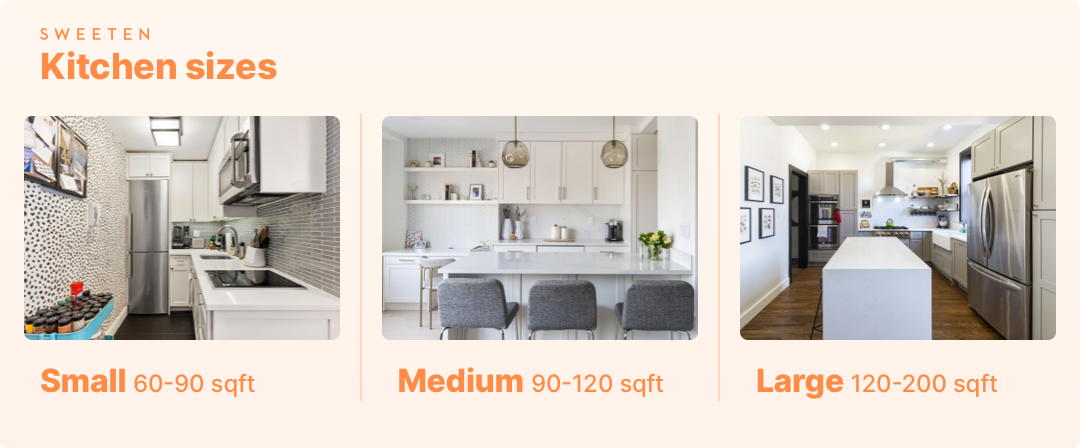
Finish level: How kitchen design affects remodeling costs in Chicago
Finish level refers to the general quality and price level of fixtures, materials, and finishes. These include countertop materials, cabinetry materials and fabrication, flooring choices, and the brands and models of sinks, faucets, and appliances you choose. The higher the finish level, the faster your costs will increase.
- Budget finish: Budget materials are generally off-the-shelf items from “big box” stores or IKEA. This includes Ikea cabinets, Wilsonart solid surface countertops, Pergo laminate floors, various tiles under $10 / square foot, fixtures by Delta and American Standard.
- Mid-grade finish: Mid-grade materials balance cost efficiency with material quality. This includes cabinets by Diamond or Kemper, Caesarstone countertops, Daltile floors, tiles by TileBar and Ann Sacks, fixtures by Brizo, Hansgrohe, or Kohler.
- High-end finish: High-end takes quality and craftsmanship above standard, and introduces custom work. This includes custom cabinets, countertops by Cambria and Neolith, floors by Porcelanosa, tiles by Cle Tile and Artistic Tile, fixtures by Graff, Kallista, or Rohl.
- Luxury finish: Luxury means the sky’s the limit, where customization, craftsmanship and materials truly go above and beyond. Think brands like La Cornue, Meneghini, or Vinotemp.
2025 Design Trends to Consider for Your Finish Level:
- Warm Neutrals: Shades of beige, caramel, and terracotta are replacing cool grays for a cozier, welcoming environment.
- Shades of Blue and Deep Greens: Making a strong comeback, from pastel to deep navy, and earthy greens, adding sophistication and depth.
- Retro ’70s Revival: Mustard yellows, olive greens, and deep browns paired with bold patterns and vintage-inspired furniture, softened for a contemporary feel.
- Curves Over Straight Lines: Furniture and architectural features are embracing flowing lines and soft edges.
- 3D Shapes: Furniture, lighting, and decor featuring geometric and sculptural designs for added depth.
- Sustainable Materials and Green Design: Eco-friendly options like bamboo, reclaimed wood, recycled fabrics, and energy-efficient appliances are increasingly popular.
- Vintage-Inspired Accessories: Incorporating antique pieces to add character and history.
- Moody Tones: Deeper, richer hues like deep greens, charcoal, and navy for a cozy and grounded effect.
- Stained Woods: Highlighting the natural beauty of wood, with hickory, walnut, and white oak being popular choices.
- Warm Whites: Cream, ivory, and soft beige creating a welcoming and less clinical atmosphere.
- Two-Tone Kitchens: Combining two colors (e.g., dark lower cabinets with lighter uppers) for visual interest.
- Smart Kitchen Technology: Integrated charging stations, touch-to-open drawers, and hidden appliance compartments.
- Expanded Pantries and Hidden Features: Luxurious, floor-to-ceiling pantries and concealed appliances for a minimalist look.
- Open Shelving: Strategically incorporated for accessibility and display, often balanced with closed cabinetry.
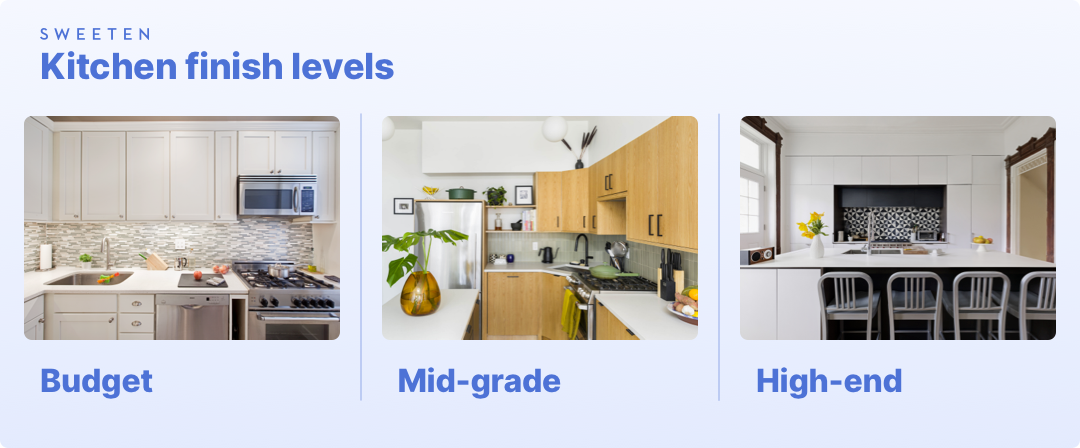
Scope: Rip-and-replace vs. gut kitchen renovation in Chicago
As you enter the kitchen renovation process, you’ll hear the term project scope. This refers to the amount and type of work that needs to be done, and can have implications on which professionals you’ll need to hire. We divide scope into the following broad categories (when a contractor prepares an estimate for your renovation, it will be much more detailed, and will include costs of the exact fixtures and finishes):
Full Renovation (also called “rip-and-replace”)
Imagine a kitchen that’s as fresh and inviting as your favorite chef’s secret recipe. A full renovation, often referred to as “rip-and-replace,” is your culinary canvas. By replacing all old fixtures and finishes, you can create a space that’s not just functional but also visually stunning.
While maintaining the existing layout, a full renovation offers a straightforward way to transform your kitchen. With the help of a licensed general contractor, you can bring your dream kitchen to life.
Gut Renovation
A gut renovation is like a culinary expedition, stripping your kitchen down to its bare bones to create a completely new space.
By removing walls, moving gas lines, rerouting plumbing, and rewiring electrical, you can transform your kitchen into a culinary masterpiece. This ambitious project requires professional design and architectural services, permits, and licensed general contractors to ensure safety and code compliance. Sweeten brings homeowners an exceptional renovation experience by personally matching trusted general contractors to your project, while offering expert guidance and support—at no cost to you. Renovate expertly with Sweeten
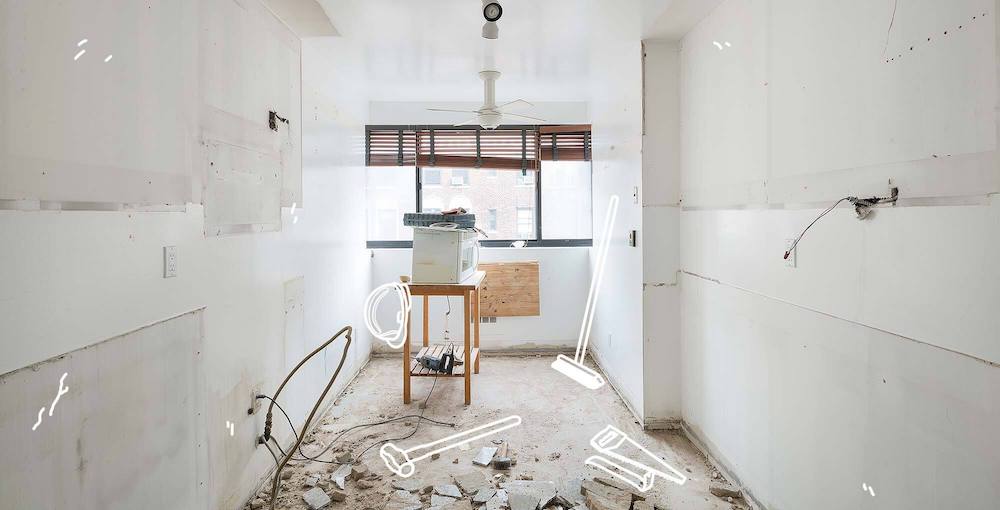
Services: Kitchen remodeling services, and how they affect costs in Chicago
The two main services to consider for your kitchen renovation are build service and design service. Depending on your needs, you have some options for what types of firms to hire.
Build service with a general contractor
Build service would include demolition and construction services, and would be carried out by your general contractor. Some general contractors are considered build-only firms, which means that they do not offer full professional design. Even within the build-only category, there are a range of different service offerings a contractor might provide — some will strictly work with finished plans from a professional designer, some will work with you to carry out the vision you conceive, and others are more willing to offer creative suggestions and advice on material and fixture choices, or even rough visualizations for spatial layout.
A combination of service level, experience, and things like firm size and overhead might all contribute to how competitive a contractor’s pricing is. We generally recommend to meet with a few different firms to feel out what level of service best suits you.
Design service with an architect or interior designer
Design service can be broken down into creative design and technical design. For creative design service, which is almost always optional, you’ll work with an architect or interior designer to reimagine the space’s design. This added layer of service will generally cost between 10-20% of your construction budget, depending on the level of service included in your design package (though, not all firms determine their fees based on cost of construction — some may charge a flat fee based on project scope and anticipated duration, for example). So, for a $50,000 kitchen renovation, you might expect to pay your architect or designer $5,000 to $10,000.
Technical design expertise is needed in the form of an architect (or sometimes structural engineer) for projects like gut renovations where permitting is required. Their main role is to ensure that the project is done safely and to code.
What is a full-service, design-build firm?
If you need both design and build services, you can choose to hire a professional designer or architect, and separately, a general contractor. But there’s another option that comes with some distinct benefits: you can hire a design-build firm — a general contractor with dedicated professional design under one roof. This means you work with the same firm from planning and design through construction. In addition to the continuity, which can often save time in the process, some clients appreciate that the working relationship means more seamless coordination, which can even help to keep your project on budget.
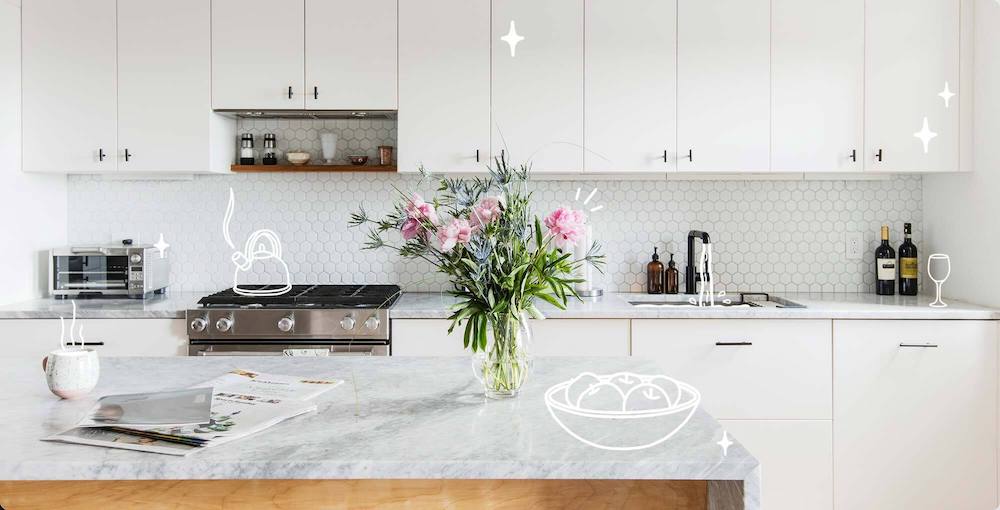
Ready to renovate? Start here for free!
Here you can learn more about our services and locations. Alternatively, browse more home renovation inspirations, processes, and cost guides.
FAQs about kitchen remodeling costs in Chicago
The process of remodeling brings up endless questions, so we’re answering some of your most common curiosities about the costs of renovation here.
The final cost of a kitchen remodel will depend on the size of your kitchen, the type of cabinets, appliance budget, and if any electrical or plumbing will be moving. Based on national averages, for a typical, medium-sized space (120 sqft), a full, rip-and-replace kitchen remodel in Chicago will range from $23,500 to $101,000 and up, depending on finishes. This estimate includes all materials, labor, overhead, and a standard general contractor margin.
A major gut kitchen remodel would add an additional 15-25% to the total cost of materials and labor for the same square footage.
Demolition signifies the start of a renovation and is one of the quickest parts of the process to complete. Typically, demolition costs are tied to the square footage of what is being removed. Generally, demolition costs start at $28 per square foot in Chicago, but can be more depending on what needs to be removed.
The cost of labor goes towards the renovation crew, behind-the-scenes administrative employees, and subcontractors. Generally, the cost of labor is dependent on a project’s complexity, size, and location. In Chicago, the labor portion of a remodeling project usually adds up to around 25-35% of the total project cost, give or take.
Generally, labor will make up a larger portion of total cost for a project with budget-grade materials, and a lower portion of the total for high-end materials, however, the addition of any highly specialized labor (beyond standard) will cost more.
Permit requirements vary between states and local municipalities, so be sure to check your local requirements. Often, permits are needed if any plumbing, electrical, or mechanical elements will be moved, or if load-bearing walls are being moved or coming down. If you need a permit for your renovation, the costs can be calculated as a flat rate for specific scopes of work or as a percentage of the cost of the project. In some areas remodeling permit costs might be as high as 10%, but it’s usually less.
Cabinet costs will vary widely depending on the cabinet type, material type, and the linear square footage that will be installed. The price range can be wide on cabinets, ranging from $177 per linear foot for stock cabinetry going up to $569 per linear foot for custom cabinetry with decorative elements, such as designer glass fronts. Double those figures per linear foot if you’re planning for both upper and lower cabinets, though lower cabinets are deeper and usually slightly more expensive than uppers. These quotes include installation costs for Chicago.
The cost of a countertop will depend on the square footage needed, the cost to install, and the type of material chosen. On the lower end, counters can start at $37 per square foot for laminate, formica, or tile, to as high as $522+ per square foot for high-end continuous, natural stone. These quotes include installation costs for Chicago.
The cost considerations for a kitchen island or peninsula include the type of cabinetry, countertop material, and any amenities to be installed, such as a sink or appliance. In total, adding a new island in Chicago, using budget-grade materials will start at about $7,000. This figure includes installation labor for Chicago.
Appliances can make up a substantial part of the renovation budget, if you are planning to replace them. “To maximize a limited budget, consider an appliance package,” explains Albert Fouerti, founder and CEO of Appliances Connection. “Sticking to a single brand might net you the most savings based on manufacturers’ rebates.”
Typically, appliance packages align into three levels – budget appliance packages which cost $5,000 and under, mid-grade packages range between $5,000-$10,000, and high-end/luxury packages that can cost $10,000 and up. An appliance package typically includes a refrigerator, range, microwave oven, and dishwasher, but could include more appliances depending on your specific renovation. Costs can be controlled by choosing finishes and features within your budget and typical use case.
The cost of a backsplash will depend on the square footage needed, the type of material chosen, and the prep and installation labor. Kitchen backsplash costs range from about $37 per square foot for a budget tile option, up to $522 per square foot for a high-end slab option, such as marble. These figures include installation labor costs for Chicago.
When renovating your kitchen, you’ll also need to choose hardware like cabinet pulls that can run as low as a few dollars a piece (though, you can also spend a lot more on higher-end items), and lighting fixtures that can be had for $73 for basic flush mounts (with installation labor), or run up to hundreds or thousands of dollars for decorative chandeliers or multiple statement pendants and under-cabinet lighting.
In Chicago, the cost for a full, rip-and-replace remodel of a small kitchen can range from $20,000-$67,000 and up, depending on finish level of the materials used. A major gut renovation for a kitchen of the same size would add an additional 15-25% to the total cost of materials and labor.
Your general contractor can give you an idea of possible issues that may arise during a renovation in Chicago, based on the age and type of home they’re working on. However, a contractor cannot price out every possible issue, especially after walls are broken into. Plumbing and electrical may need to be updated, or lead/asbestos may need to be removed. Major projects often involve permit costs. Change orders after a contract has been signed can also add to the overall cost.
To protect yourself from unseen costs, set aside a 10-15% contingency budget for a non-gut renovation. If you are planning a gut remodel, set aside 15-20% for issues that come up along the way. Having a monetary cushion will keep your remodeling project on track. If you don’t end up needing it, you can use the extra funds to pay down loans or furnish your beautiful new space.
Common kitchen layouts in Chicago include galley, L-shaped, U-shaped, island, and peninsula kitchens. Galley kitchens are highly-efficient layouts and usually on the smaller end for kitchen size because there is limited floor space; that said, they focus their efficiency on cabinets and countertop space, which are bigger ticket items for pricing. In the medium to large size range, you might have an L-shaped kitchen or a U-shaped kitchen. Many open layout kitchens feature an island or peninsula.
In all of these cases, your big-ticket items like cabinets, countertops and appliances will swing your overall costs higher or lower depending on the overall size or volume and finish level. If you don’t need a lot of cabinet space, consider limiting upper cabinets or incorporating some open-shelving in your kitchen design to reduce costs.
Are you ready to start your own kitchen remodeling project?
Post your remodeling project on Sweeten and we’ll connect you with a curated list of trusted contractors, matched to your project. Our service is free for homeowners, and hiring your contractor with Sweeten means you’ll also have access to advice, support, and secure payments. Check out our service locations to see if we cover your area.
Renovate to live, Sweeten to thrive! Learn more
Read more cost and process guides below:
- Chicago Bathroom Remodeling Costs
- Chicago Home Remodeling Costs
- Expert Guide to Basement Remodeling in Chicago
—
Sweeten handpicks the best general contractors to match each project’s location, budget, scope, and style. Follow the blog, Sweeten Stories, for renovation ideas and inspiration and when you’re ready to renovate, start your renovation with Sweeten.
